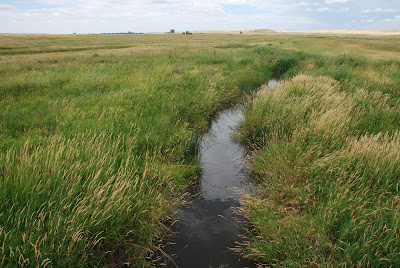Niobrara Wild and Scenic River
In a region where many of the rivers have been transformed by irrigation and dams, the Niobrara remains as one of the last free-flowing rivers of the Great Plains. It flows east across the northern half of Nebraska before it joins the Missouri River on the border with South Dakota.
On a cross country tour of rivers, my son and I spent a couple days exploring the Niobrara. We camped out at Rock Barn and then got a shuttle up to the start at Cornell Bridge which is a popular put-in for canoe trips.
 The river starts out in the Congressionally designated Wilderness within the Fort Niobrara National Wildlife Refuge.
The river starts out in the Congressionally designated Wilderness within the Fort Niobrara National Wildlife Refuge. My son Aki enjoyed the dozens of waterfalls that cascade into the river.
My son Aki enjoyed the dozens of waterfalls that cascade into the river. The biggest waterfall on the river and in fact the tallest in Nebraska is Smith Falls.
The biggest waterfall on the river and in fact the tallest in Nebraska is Smith Falls. My son Aki playing at the base of Smith Falls with dozens of other little kids out enjoying the river. There's been a lot of discussion regarding the need to get kids in the outdoors. My idea: Give them all water cannons, buckets, and turn them loose on a river like the Niobrara. They were all having a great time.
My son Aki playing at the base of Smith Falls with dozens of other little kids out enjoying the river. There's been a lot of discussion regarding the need to get kids in the outdoors. My idea: Give them all water cannons, buckets, and turn them loose on a river like the Niobrara. They were all having a great time. Give a guy a beer, put him in a boat, and he'll run anything. Here a paddler runs the right side ledge at Fritz's Island which is generally discouraged by those renting out the boats (they ask you to take the easier left side channel).
Give a guy a beer, put him in a boat, and he'll run anything. Here a paddler runs the right side ledge at Fritz's Island which is generally discouraged by those renting out the boats (they ask you to take the easier left side channel). My son abandoning the paddle for something a little more dynamic--kicking the boat down the river or maybe it was just around in circles.
My son abandoning the paddle for something a little more dynamic--kicking the boat down the river or maybe it was just around in circles. After paddling about 30 miles of the Wild and Scenic section we traveled across the state and explored the headwaters where the river is little more than a irrigation ditch flowing through agricultural lands bordered by an arid landscape.
After paddling about 30 miles of the Wild and Scenic section we traveled across the state and explored the headwaters where the river is little more than a irrigation ditch flowing through agricultural lands bordered by an arid landscape. The river provides water for irrigation but as it sprays into the air flows on the section we enjoyed downstream are diminished. The National Park Service recently conducted a study of instream flow needs for recreation. As demand for irrigation water continues to increase the spectacular and regionally significant recreational opportunities could be lost.
The river provides water for irrigation but as it sprays into the air flows on the section we enjoyed downstream are diminished. The National Park Service recently conducted a study of instream flow needs for recreation. As demand for irrigation water continues to increase the spectacular and regionally significant recreational opportunities could be lost.Labels: wild and scenic

<< Home